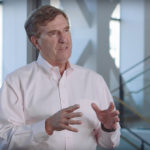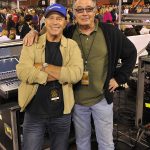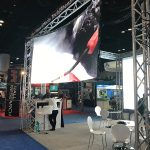A Life of Lighting for the Camera
Bill Klages already has seven Primetime Emmy Awards for his work in television lighting design. This year, his long and stunning career has been officially recognized with his 2012 induction into the Television Academy Hall of Fame. Klages is living television history himself. From the earliest days of television in the late 1940s, through the big variety shows of the 1950s and 1960s like The Perry Como Show and specials including Color Me Barbra and onward to major events like Atlanta Olympic Games, The Grammy Awards, The Tony Awards, The Republican National Convention (Houston 1992, Philadelphia 2000, New York 2004, St. Paul 2008), The Los Angeles Olympics Closing Ceremonies, The Statue of Liberty Celebration, The Country Music Awards, The Emmy Awards, The Kennedy Center Honors, and so much more. His work also includes movies, like working on the live scenes of 2004’s Ray, the academy-award winning biopic on the life of Ray Charles (Jamie Foxx won the Oscar for Best Actor).
Klages is living television history himself. From the earliest days of television in the late 1940s, through the big variety shows of the 1950s and 1960s like The Perry Como Show and specials including Color Me Barbra and onward to major events like Atlanta Olympic Games, The Grammy Awards, The Tony Awards, The Republican National Convention (Houston 1992, Philadelphia 2000, New York 2004, St. Paul 2008), The Los Angeles Olympics Closing Ceremonies, The Statue of Liberty Celebration, The Country Music Awards, The Emmy Awards, The Kennedy Center Honors, and so much more. His work also includes movies, like working on the live scenes of 2004’s Ray, the academy-award winning biopic on the life of Ray Charles (Jamie Foxx won the Oscar for Best Actor).
He served as broadcast lighting consultant when the 21,000-seat LDS Conference Center in Salt Lake City was opened in 2000. He also designed the broadcast lighting facilities and lighting design for Lakewood Church’s 16,000-seat sanctuary in Houston, home base for senior pastor Joel Osteen.
Today Klages continues to design and also lecture and conduct seminars. He recently sat down with PLSN to discuss his amazing career shortly before being inducted into the Television Academy Hall of Fame.
PLSN: How did you get into lighting?
Bill Klages: I went to work for NBC in November of 1948 as an electrical engineer — I had a Masters’ in electrical engineering. My first duty was technical, but then I became a video engineer because they made more money! [Laughs] I always had an interest in getting a good visual image, which was difficult, and I observed from there that the key was the lighting. Then I went into the Navy for two years, then returned to NBC and the opportunity came up to do a 90-minute live show [Playwright’s’56] that would be competition to the popular Playhouse 90. It was the first big show I ever lit.
And like that you were a lighting designer?
[Laughs] It was a series of events that could have only occurred back then. A cameraman named Larry Elikann said [to the producers], “He has never lighted anything, but this guy will be the best in the business.” Larry went onto a very successful directing career.
So real on-the-job training then …
I was observing other guys. I knew fairly quickly what it took to make a good picture, I just had to prove it. Everybody was stumbling about looking for a solution back then, because the camera was extremely difficult to deal with. That was the main stumbling block.
What were some of your biggest breaks in the early days?
The first came when I was a video man. I did all the large shows — Your Hit Parade, then Robert Montgomery Presents… I was always at the level so I started lighting at the top!
My second was working on Washington Square, then Ernie Kovac Show, and then Perry Como … there were many big breaks just because I was there! The shows kept coming to me.
What was it like, trying to find the tools you needed?
That’s an unfortunate thing to bring up. Theatrical equipment manufacturers presented themselves as TV experts. But I was one of the early guys who wouldn’t accept that. I realized that TV was more like movies [than theater]. So that equipment was needed because that’s what we wanted to copy. I’d go to a film and see how gorgeous it looked, and then looked at how terrible TV looked. Now most of it was the camera itself, but the lighting equipment needed to be better too.
Really, the biggest break for television was moving lights, and equipment and tricks that came from the live concert world, which we adapted immediately — but that came much later of course.
Is lighting for television “easier” than live events or concerts or film?
No. Each [discipline] has its own complicated approaches. Lighting has to accommodate the media. In theater, you’re accommodating the eyes. It takes a while for the theater lighting person to get it if they get it at all.
You must know the restrictions of each one. Both have the same idea: something pleasing. But how you do it is different. Of course, when I do a live event, I have a difficult time: I have to keep remembering what I’m trying to do and remember the eye compared to a piece of film or tape.
What have been some of the biggest technical developments for you?
The biggest development has been the camera in terms of sensitivity, and that continues today. A consumer camera today has better resolution than what we were using in the 1950s by far. As far as lighting equipment … the control systems, the new lights, that’s all been icing on the cake. But it’s been about the camera’s development.
Talk about the evolution of black and white to color …
In the beginning, the sensitivity problem took a lot of light, and we were always struggling to get a proper exposure level. As cameras developed, it got better … but then we had color, and we had to take a step back before that camera got better.
Film guys would make fun of us, and they were right! Nowadays they are on our team, as all of the large cameras are precise tools.
 One of your many notable credits is working on the “live” aspects of Ray Charles in concert in the movie Ray. What were those challenges?
One of your many notable credits is working on the “live” aspects of Ray Charles in concert in the movie Ray. What were those challenges?
It was interesting, because the director [Taylor Hackford] wanted me to make it as theatrical as possible. We shot all those concert scenes in two theaters, but we made it look like 10 by selective views.
If you press me on how I did it, I’ll have to say I lit it exactly like I would a television variety show with an audience. Exactly. Film production is not fast-paced, and they aim for absolute perfection. There’s less time lighting for TV productions, less time between shots, so a little bit of slight refocusing and moving fast worked. You do work extremely fast in television, because there isn’t a lot of time. But we have all the tools, console control, etc., and we use all of that to our advantage.
So much of your work — the Atlanta Olympic Games, Republican Conventions, Kennedy Honors, etc. — have been as much for the live audience as for television. How do you reconcile that and make the lighting work for both?
The two are not consistent. If the live audience sees something that is pleasing it’s an accident. None of these events I approach as an live audience event. It’s a television event, and the audience gets what they get. You cannot be concerned about their comfort or glare or whatever because, if you do, the television part will suffer. So they get what they get! [Laughs]
What are some of the things they “get”?
In lighting for theater, if I show you the edges of the proscenium, I’d get drummed out of the business! But in television, you show it. Otherwise you don’t know you’re in a theatre. So, in essence, yes, I have lit large-scale events, even ones with large studio audiences — but I never concern myself with the live audience.
You can imagine how many times a theatre producer has said to me, “now, bear in mind the live audience, and we want them to be comfortable,” and as tactfully as you can, you say, “Yes, I will,” but it’s a fabrication.
What are the biggest challenges of these events? The stakes are high, you only have one shot at it …
You just have to relax and do it. There’s always anxiety, particularly if something isn’t in the most ideal situation. You just have to count on your own experience, ingenuity and self-confidence. Who doesn’t question themselves?
Or — seek help! I’ve had other designers call me saying they wonder how I do something, and you pass that information on.
How about typical creative conflicts between designers and producers and directors?
Actually, there’s not too much at the level that I work at. There’s really very little conversation in all my experiences. Maybe a few comments … [Laughs]. You get funny comments sometimes, and a few temperamental artists, but as far as anything big … luckily I’ve never had that. It seems strange … nobody had said, “You missed it here,” or “It should have been red, not blue.” Isn’t it nice? It’s been ideal.
The cliché is the especially sensitive actor or actress blaming the lighting designer on how they look …
No … well, once, but I didn’t take it personally. You just have to understand people and place yourself in their position. In those situations, I don’t talk about my method. I would rather change it, make it better for them. Art directors — same situation … how can you make it better? How can you make it work? No matter how crazy a person is, help them. Always be part of the team.
Talk about technology in lighting. Is “the latest and greatest” something you’re always researching?
Oh, sure. It’s great to see what people come up with. But change comes pretty slowly, and you find that a lot of things are not important. Control systems — they’ve gotten extremely sophisticated, but you have to understand how it fits your approach. Remember, somebody wants to sell you something! I find it’s best to approach those things timidly. I don’t accept something on someone’s say-so. I have to try it. If I do try it, I tell them what I think. And not all the news is positive.
I guess your door gets knocked on a lot by manufacturers …
Constantly. What happens is, you can become obsessed that you’re not using everything new — No! No! No! You have to really learn the tools. A simple Fresnel can be the study of the lifetime. So with new equipment, I ask, “How is it going to help me?” Usually you fall back on tried-and-true solutions.
But today, you’re not going to find somebody in a basement creating something great any more. It’s all coming from large manufacturers. LED is a perfect example. But it’s overloaded, over-sold, and not completely there yet. There are some advantages, but as an answer for all your problems … there’s no single instrument that can do that.
What are your lectures and seminars like?
I try to show people how I light something. No kidding around, no theory, just do it — because everybody has to have that basis. I know more because I went through the terrible days with terrible cameras, and now it’s easier. You have the tools and a way to do it, there’s a lot of information.
The teaching part is fun, but I feel the sessions should be lengthy — like three or four weeks! I also like to give them technical background, calculations, talk about camera operation and how it works — and that all takes a lot of time too. I don’t always feel seminars allow enough time …
Can you offer some advice to those wanting to get into television lighting?
I can’t. I’m just glad I began in the era I did. I don’t see everybody having as much fun as they should be. It’s gotten too serious, too much is at stake, supposedly. They don’t enjoy it as much as they should. If people are interested, I tell them what I know. I can’t get them work, and I feel saddened because of it.


